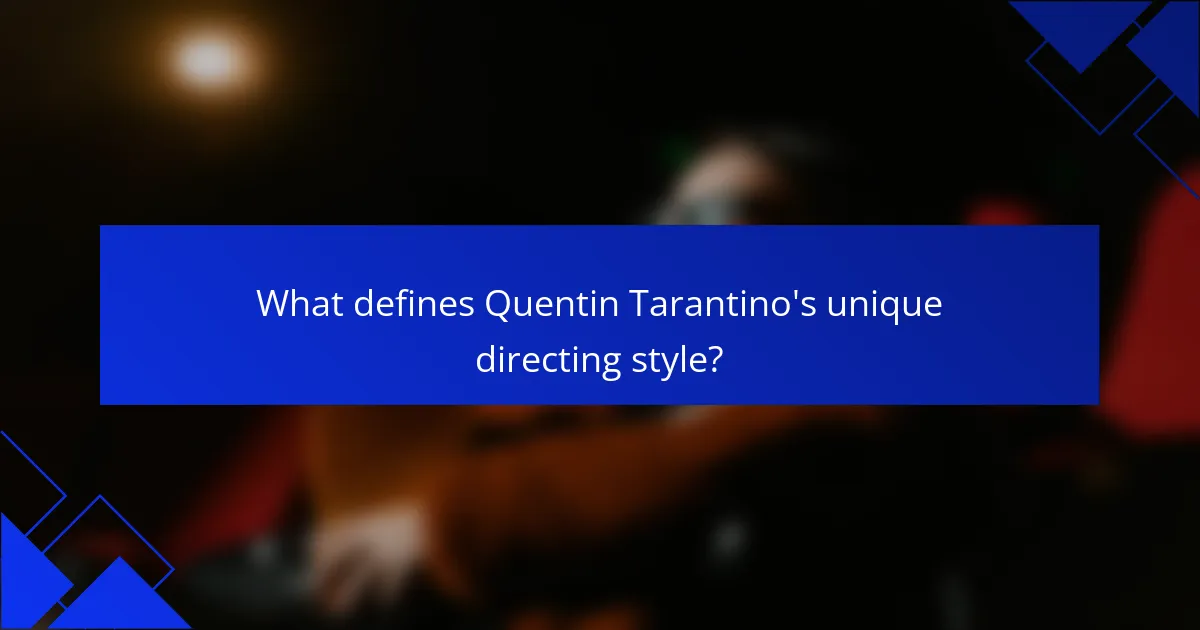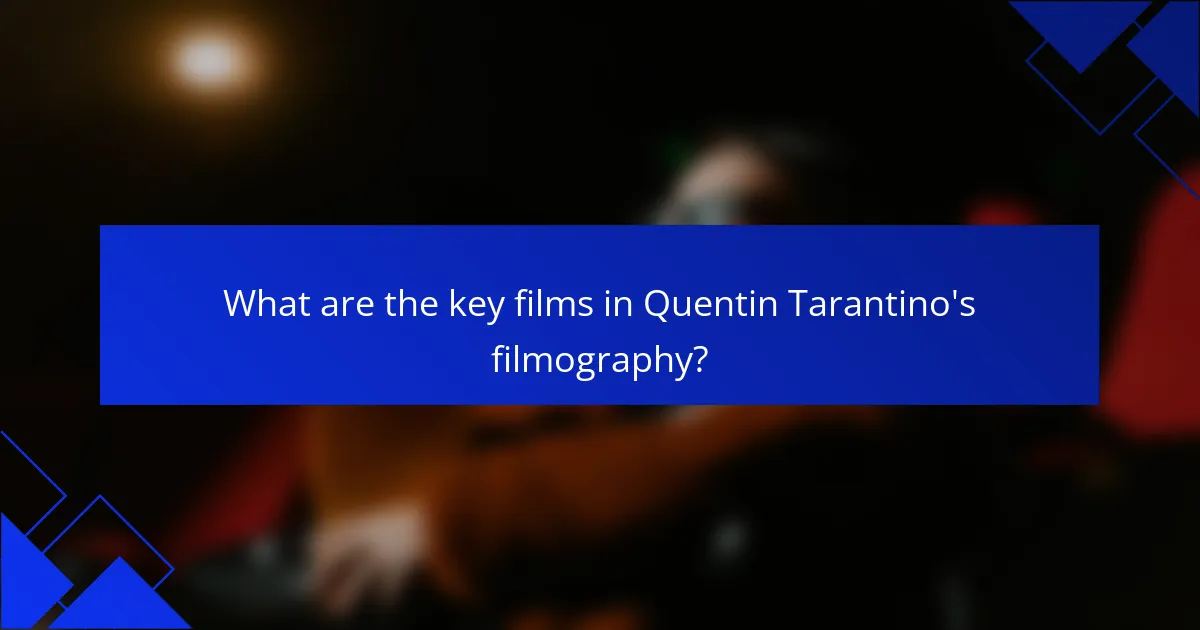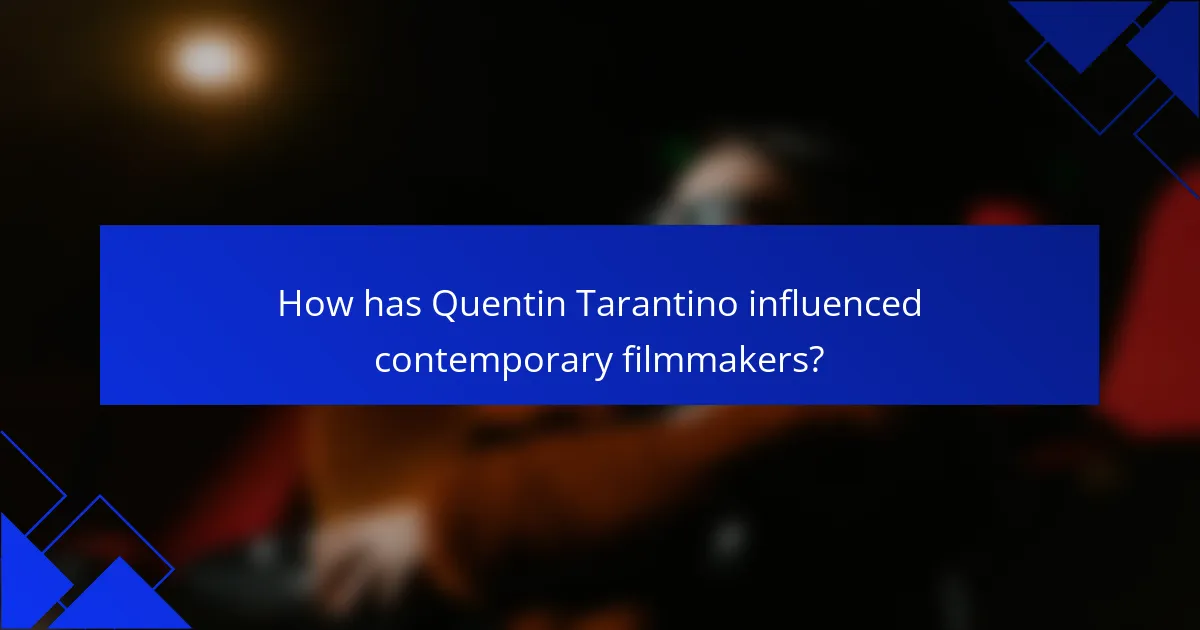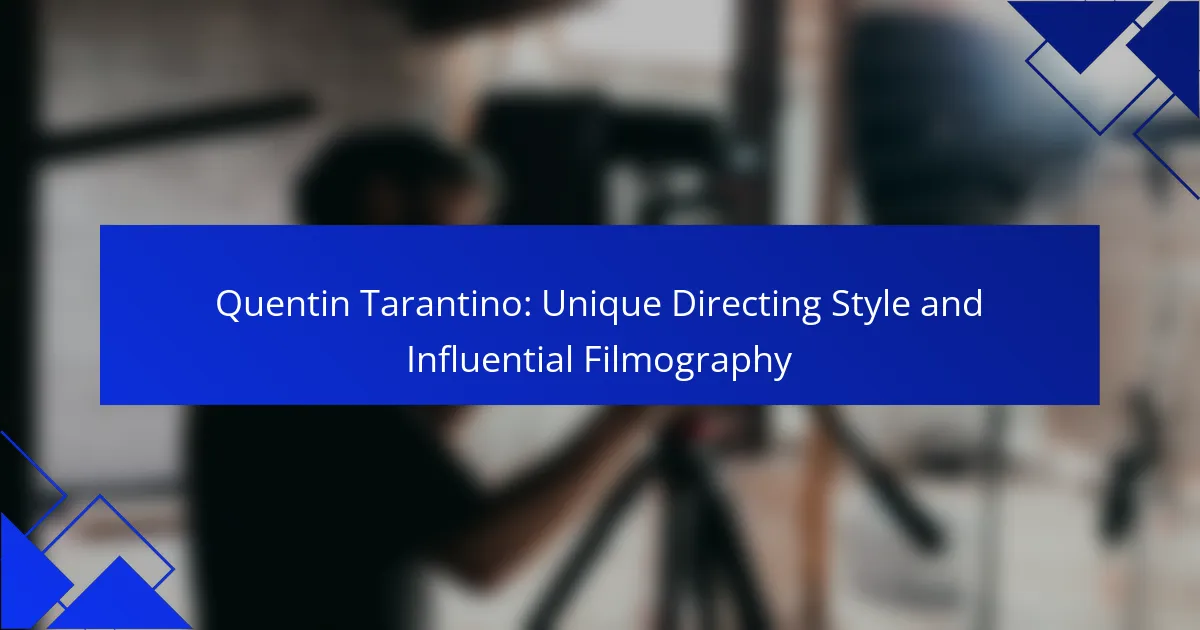
What defines Quentin Tarantino’s unique directing style?
Quentin Tarantino’s unique directing style is defined by his innovative storytelling techniques and distinctive visual aesthetics. He often employs non-linear narratives, which create suspense and engage audiences. Tarantino’s dialogue is sharp and memorable, often blending humor with intense drama. His films frequently feature long takes and dynamic camera movements that enhance the storytelling. He has a penchant for pop culture references, which adds layers to his narratives. Tarantino is also known for his use of violence, which he stylizes in a way that provokes thought and discussion. His soundtracks are carefully curated, often featuring eclectic music that complements the film’s mood. These elements combined create a signature style that is instantly recognizable and influential in modern cinema.
How does Tarantino’s approach to storytelling influence his films?
Tarantino’s approach to storytelling significantly influences his films through non-linear narratives and rich dialogue. His films often feature fragmented timelines, which create suspense and intrigue. For example, “Pulp Fiction” employs this technique to interweave multiple storylines. This structure challenges traditional storytelling methods and engages viewers in active interpretation. Additionally, Tarantino’s use of sharp, memorable dialogue enhances character development and thematic depth. His characters often deliver monologues that reveal their motivations and personalities. The dialogue also serves to build tension and humor, enriching the viewing experience. Collectively, these elements contribute to a distinctive cinematic style that defines Tarantino’s work.
What narrative techniques does Tarantino frequently employ?
Tarantino frequently employs non-linear storytelling in his films. This technique allows him to present events out of chronological order. It creates suspense and engages the audience in piecing together the narrative. Tarantino often uses dialogue-heavy scenes to develop characters and advance the plot. His characters frequently engage in conversations that reveal their personalities and motivations. Additionally, he incorporates homage and references to other films, creating intertextual connections. This technique enriches the viewing experience for cinephiles. He also utilizes graphic violence and stylized action sequences to provoke strong emotional responses. These narrative techniques are integral to his distinctive filmmaking style.
How does non-linear storytelling impact audience engagement?
Non-linear storytelling enhances audience engagement by creating intrigue and encouraging active participation. This narrative structure allows viewers to piece together the story from various timelines. It fosters a sense of discovery, as audiences must pay close attention to understand the plot. Research indicates that non-linear narratives can lead to higher emotional investment. A study from the University of Southern California found that viewers of non-linear films reported stronger emotional responses. This engagement is often due to the challenge of deciphering the narrative. Consequently, non-linear storytelling can result in a more memorable viewing experience.
What visual elements characterize Tarantino’s directing style?
Tarantino’s directing style is characterized by distinctive visual elements. He frequently employs non-linear storytelling, creating a unique narrative structure. His use of vibrant color palettes enhances emotional resonance in scenes. Tarantino often incorporates long takes, allowing tension to build organically. He utilizes close-ups to emphasize character emotions and reactions. Iconic shot compositions, such as the “trunk shot,” are hallmarks of his style. Additionally, he integrates dynamic camera movements, including whip pans and tracking shots. These elements contribute to a visually engaging cinematic experience.
How does cinematography contribute to the overall aesthetic of his films?
Cinematography significantly contributes to the overall aesthetic of Quentin Tarantino’s films. It shapes the visual storytelling and enhances emotional engagement. Tarantino employs vibrant color palettes, which create striking visuals. He often uses unconventional framing and angles to provoke thought. The use of long takes adds to the immersive experience. Lighting is meticulously crafted to evoke specific moods. Camera movements often reflect character dynamics and narrative tension. These techniques collectively establish a unique visual identity. The cinematography in films like “Kill Bill” and “Inglourious Basterds” exemplifies this artistic approach.
What role does color and lighting play in Tarantino’s work?
Color and lighting play a crucial role in Quentin Tarantino’s work. They enhance the emotional tone and narrative depth of his films. Tarantino often employs vibrant colors to evoke specific moods. For example, the use of red in “Kill Bill” symbolizes violence and revenge. Lighting is meticulously crafted to create dramatic contrasts. High-key lighting is used in some scenes for a playful effect. Conversely, low-key lighting heightens tension and suspense in others. Tarantino’s color palette often references genres like neo-noir and spaghetti westerns. This stylistic choice reinforces his homage to cinematic history. Overall, color and lighting are integral to Tarantino’s storytelling approach.

What are the key films in Quentin Tarantino’s filmography?
Pulp Fiction, released in 1994, is a key film in Quentin Tarantino’s filmography. It is renowned for its nonlinear storytelling and sharp dialogue. Another significant film is Reservoir Dogs, which debuted in 1992. This film marked Tarantino’s directorial debut and showcased his unique style. Kill Bill: Volume 1, released in 2003, is also essential. It features a blend of martial arts and revenge themes. Django Unchained, from 2012, explores themes of slavery and revenge with a distinct narrative approach. Inglourious Basterds, released in 2009, is notable for its alternate history of World War II. Each of these films has received critical acclaim and contributed to Tarantino’s reputation as a filmmaker.
Which films are considered Tarantino’s most influential works?
Pulp Fiction, released in 1994, is considered Tarantino’s most influential work. It revolutionized narrative structure in cinema with its non-linear storytelling. The film received critical acclaim and won the Palme d’Or at the Cannes Film Festival. Reservoir Dogs, his debut film from 1992, also had a significant impact on independent filmmaking. It showcased sharp dialogue and a unique approach to violence. Kill Bill: Vol. 1 and Vol. 2, released in 2003 and 2004, respectively, are influential for their stylistic homage to martial arts films. Django Unchained, released in 2012, sparked discussions on race and representation in film. Each of these films contributed to Tarantino’s reputation for blending genres and creating iconic scenes.
What themes are prevalent in “Pulp Fiction” and how do they reflect Tarantino’s style?
“Pulp Fiction” features themes of violence, redemption, and moral ambiguity. These themes highlight Tarantino’s distinctive narrative style. The film intertwines multiple storylines, showcasing characters facing moral dilemmas. Violence is depicted in a stylized manner, often juxtaposed with dark humor. Redemption arcs are present, particularly in characters like Jules, who seeks a new path. The non-linear storytelling reflects Tarantino’s innovative approach to narrative structure. Additionally, the dialogue-driven scenes emphasize character development and thematic depth. These elements collectively illustrate Tarantino’s unique cinematic voice, making “Pulp Fiction” a landmark film in his career.
How did “Kill Bill” redefine action cinema?
“Kill Bill” redefined action cinema through its stylistic innovation and genre-blending. The film incorporates elements of martial arts, spaghetti westerns, and revenge narratives. Its distinctive visual style features vibrant colors and dynamic cinematography. The choreography of fight scenes is meticulously crafted and highly stylized. Tarantino’s use of non-linear storytelling adds depth to the narrative. The film also emphasizes strong female protagonists, challenging traditional gender roles in action films. Additionally, it revives and pays homage to classic cinema influences. The soundtrack features an eclectic mix of genres, enhancing the film’s emotional impact. Overall, “Kill Bill” set a new standard for creativity and storytelling in action cinema.
What awards and recognition has Tarantino received for his films?
Quentin Tarantino has received numerous awards and recognition for his films. He won two Academy Awards for Best Original Screenplay for “Pulp Fiction” in 1995 and “Django Unchained” in 2013. Tarantino has also received the Palme d’Or at the Cannes Film Festival for “Pulp Fiction” in 1994. He has been honored with multiple Golden Globe Awards, including Best Screenplay for “Django Unchained” and “Once Upon a Time in Hollywood.” Additionally, he received the BAFTA Award for Best Original Screenplay for “Pulp Fiction.” His films have earned him accolades from various critics’ associations and film festivals worldwide. These awards highlight his significant impact on cinema and storytelling.
How do these accolades reflect his impact on the film industry?
Quentin Tarantino’s accolades reflect his significant impact on the film industry through recognition of his unique storytelling and innovative techniques. His films have received numerous awards, including multiple Academy Awards and Golden Globes. These honors highlight his ability to blend genres and create compelling narratives. For instance, “Pulp Fiction” won the Palme d’Or at the Cannes Film Festival, showcasing international acclaim. His distinctive dialogue and non-linear storytelling have influenced countless filmmakers. Tarantino’s work has also revitalized interest in certain genres, such as the Western and crime films. Overall, his accolades serve as a testament to his lasting influence and contributions to cinema.
What are the critical responses to his work over the years?
Quentin Tarantino’s work has received a mix of critical acclaim and controversy over the years. Critics often praise his unique storytelling techniques and dialogue. His films frequently showcase nonlinear narratives and rich character development. For instance, “Pulp Fiction” is lauded for its innovative structure and cultural impact. However, some critics highlight issues with violence and representation in his films. Tarantino’s use of graphic violence has sparked debates about its necessity and influence. Additionally, his portrayal of race and gender has drawn scrutiny. Despite these criticisms, many filmmakers cite Tarantino as an inspiration. His distinctive style has left a lasting mark on cinema. Overall, critical responses reflect both admiration and concern regarding his artistic choices.

How has Quentin Tarantino influenced contemporary filmmakers?
Quentin Tarantino has significantly influenced contemporary filmmakers through his unique storytelling techniques and stylistic choices. His non-linear narratives challenge traditional storytelling methods. Films like “Pulp Fiction” popularized this approach, inspiring directors to experiment with structure. Tarantino’s dialogue-driven scenes emphasize character development and wit, encouraging filmmakers to focus on dialogue quality. His homage to genre cinema has led to a resurgence of genre-blending in modern films. The use of violence in a stylized manner has sparked discussions about its portrayal in cinema. Tarantino’s soundtracks often feature eclectic music choices, influencing how contemporary filmmakers select music to enhance storytelling. His emphasis on strong, complex characters has encouraged a shift towards more nuanced character portrayals in modern filmmaking.
What aspects of Tarantino’s style have been adopted by other directors?
Tarantino’s style has been widely adopted by other directors, particularly his non-linear storytelling. This technique allows for complex narrative structures that engage audiences. Another aspect is his use of dialogue, which often features sharp wit and cultural references. Directors have emulated this to add depth to their characters. Additionally, Tarantino’s blending of genres has inspired filmmakers to mix elements from different styles. His distinctive visual flair, including striking cinematography and bold color palettes, has also influenced visual storytelling in modern cinema. Lastly, the incorporation of pop culture elements in narratives has become a hallmark in various films following his lead.
How do modern filmmakers incorporate Tarantino’s narrative techniques?
Modern filmmakers incorporate Tarantino’s narrative techniques through non-linear storytelling and sharp dialogue. They often use fragmented timelines to create suspense and engage audiences. This technique allows for unexpected plot twists, a hallmark of Tarantino’s style. Additionally, filmmakers emulate his use of pop culture references to add depth and relatability. They also adopt his character development approach, focusing on morally ambiguous characters. This complexity invites viewers to explore themes of redemption and betrayal. Films like “Baby Driver” and “The Hateful Eight” showcase these techniques effectively. Such incorporation reflects Tarantino’s lasting influence on contemporary cinema.
What elements of his films have become trends in the industry?
Quentin Tarantino’s films have introduced several influential trends in the industry. His non-linear storytelling has reshaped narrative structures in cinema. Many filmmakers now adopt this approach to create suspense and intrigue. Additionally, Tarantino’s use of sharp, witty dialogue has set a new standard for character interactions. This has influenced screenwriting across various genres. His blending of genres, particularly combining elements of crime, westerns, and martial arts, has encouraged filmmakers to experiment with genre fusions. The emphasis on strong, complex female characters in his films has also inspired a shift towards more diverse representations. Furthermore, Tarantino’s distinct visual style, characterized by vibrant colors and stylized violence, has become a reference point for modern cinematography. His soundtracks, often featuring eclectic music choices, have encouraged filmmakers to curate soundtracks that enhance storytelling. These elements collectively highlight Tarantino’s significant impact on contemporary filmmaking.
What lessons can aspiring filmmakers learn from Tarantino’s career?
Aspiring filmmakers can learn several key lessons from Quentin Tarantino’s career. First, Tarantino emphasizes the importance of a strong narrative. His films often feature intricate plots and engaging dialogue. Second, he showcases the value of genre blending. Tarantino mixes elements from various genres to create unique storytelling experiences. Third, he demonstrates the power of character development. His characters are often complex and memorable, which resonates with audiences. Fourth, Tarantino highlights the significance of personal style. His distinct visual and storytelling techniques set his work apart. Finally, he illustrates the benefit of passion projects. Tarantino often creates films that reflect his personal interests and influences. These lessons contribute to his success and influence in the film industry.
What best practices can be derived from his unique storytelling approach?
Best practices derived from Quentin Tarantino’s unique storytelling approach include non-linear narratives, strong character development, and dialogue-driven scenes. Non-linear narratives engage audiences by revealing plot elements out of chronological order. This technique creates suspense and encourages viewers to piece together the story themselves. Strong character development is essential, as it allows for complex personalities that resonate with audiences. Tarantino’s characters often have rich backstories and distinct motivations, making them memorable. Additionally, his focus on dialogue creates tension and reveals character traits organically. The dialogue in his films is often sharp, witty, and laden with subtext, enhancing the viewer’s experience. These practices contribute to the distinctiveness of Tarantino’s films and their lasting impact on cinema.
How can filmmakers apply Tarantino’s techniques to their own projects?
Filmmakers can apply Tarantino’s techniques by incorporating non-linear storytelling. This approach allows them to create suspense and surprise in their narratives. They can also use sharp, witty dialogue to enhance character development and engagement. Tarantino’s use of genre-blending can inspire filmmakers to mix styles for unique storytelling.
Additionally, filmmakers can adopt his emphasis on strong character arcs. Creating memorable characters with distinct voices can resonate with audiences. They should also consider Tarantino’s use of music to evoke emotions and set the tone. Choosing iconic soundtracks can elevate the viewing experience.
Lastly, filmmakers can study Tarantino’s visual style. His meticulous framing and attention to detail can inform their cinematography choices. By analyzing these elements, filmmakers can infuse their projects with a Tarantino-esque flair.
Quentin Tarantino is the primary entity of this article, which examines his unique directing style and influential filmography. The article outlines key aspects of Tarantino’s filmmaking, including his innovative storytelling techniques, such as non-linear narratives and sharp dialogue, as well as his distinctive visual aesthetics characterized by vibrant color palettes and dynamic cinematography. It also highlights significant films in his career, such as “Pulp Fiction,” “Kill Bill,” and “Django Unchained,” while discussing the themes, narrative techniques, and critical responses that define his work. Additionally, the article explores Tarantino’s impact on contemporary filmmakers and the industry at large, offering insights into best practices and lessons for aspiring filmmakers.
